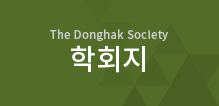pISSN: 1598-7566 / eISSN: 2713-3605
동학학보, Vol.74 (2025)
pp.45~84
DOI : 10.46639/kjds.2025.74.2
퇴계와 수운의 일생·심성·수양론 비교연구
이 논문은 퇴계와 수운의 일생과 심성·수양론을 비교하는 것이다. 먼저 일생 부분에서는 퇴계는 70세에 돌아가셨기 때문에 물리적인 시 간이 많았다. 그래서 천천히 충분히 공부를 할 수 있었다. 반면에 수운 은 41세에 돌아가셨기 때문에 퇴계처럼 긴 시간이 없었다. 그래서 빠 른 시간 내에 할 수밖에 없는 상황이었다. 그렇다고 모든 사람이 시간 이 많다고 반드시 진리를 체득하는 공부를 하는 것은 아니다. 퇴계처 럼 긴 시간을 두고 이치를 깨닫는 공부를 한 것은 쉽지 않은 것이었다. 특히 말년으로 갈수록 시간을 헛되이 보내지 않고 오로지 주자가 말한 이치를 깨닫기 위해서 깊은 숲속으로 공부를 하러 간 것은 참으로 보기 드문 일이다. 수운도 마찬가지다. 진리를 빨리 깨닫기 위해서 천성산 자연동굴을 선택해서 49일 기도를 한 것은 진리에 대한 갈망이 없이는 정말로 불가능한 일이다. 이것이 두 분의 공통점이었다. 다른 점은 퇴 계는 긴 시간을 두고 돌아보는 시간을 충분히 가지고 공부를 한 것이었 고, 수운은 짧은 시간 내에 진리를 깨달을 수밖에 없었기 때문에 충분 히 돌아볼 수 있는 시간이 부족했다. 두 번째 비교한 부분은 ‘리발’과 ‘천주’였다. 퇴계가 완성한 진리의 모습은 ‘리(理)가 발함에 기(氣)가 따 르고, 기(氣)가 발함에 리(理)가 탄다는 것’이었다. ‘리발’과 ‘기발’ 두 가 지가 모두 선(善)하지만 상황에 따라서는 악으로 변할 수도 있다. 리가 완전히 자리를 잡기 전에 기가 작용하여 리의 움직임을 막아버리면 악 으로 변한다고 했고, 또 하나는 기가 발하는 것은 악으로 가는 것이지 만 이것을 선으로 변하게 하는 것이 리가 타는 것인데 리가 타기 전에 기가 너무 힘을 쓰게 되면 악으로 변한다고 하였다. 바로 여기에서 세 번째 비교가 가능하다. 수양론이다. 악으로 변하기 전에 리가 힘 있게 작용하도록 만드는 것이다. 퇴계는 그 방법으로 ‘거경궁리’를 말했지만 ‘거경’ 중심으로 변화시켰다. 일이 있을 때나 없을 때나 모두 ‘경’을 중 심으로 하여 마음을 키워서 일이 없을 때는 어둡지 않게 늘 깨어있게 하고, 일이 있을 때는 늘 깨어있게 하여 잡념으로 흔들리지 않도록 하 는 게 퇴계의 방법이었다. 수운의 수련법은 21자 주문을 외워서 자신 이 모시고 있는 한울님을 만나서 성인이 되는 것이었다. 3대 스승 손병 희는 무조건 외우기보다는 의심을 하는 방법을 만들어서 새로운 주문 수련법을 만들었다. 그런 방법이 나온 것은 사람마다 성향이 다르기 때문이었다. 자신의 성향에 따라서 주문을 이용하여 한울님을 만나도 록 한 것이었다. 퇴계와 수운의 수련법의 공통점은 하나에 집중하여 마음을 깨어있도록 하는 것이었고, 다른 점은 퇴계는 집중하는 하나의 대상이 상황에 따라서 달랐지만, 수운은 오로지 21자 주문만을 대상으 로 하였다. 그 이유는 공부를 하는 대상이 서로 달랐기 때문이다. 퇴계 의 제자들은 학문을 주로 하는 선비들이었기 때문에 다양하게 집중하 는 대상을 바꾸어도 적응을 할 수 있는 학문적인 바탕을 가지고 있었지 만, 수운의 제자들은 글을 잘 모르는 일반 백성들이었기 때문에 집중 하는 대상을 자주 바꾸면 한울님을 만나는데 상당한 어려움이 있었기 때문이었다.
A Comparative Study on Theories of Human Nature and Self Cultivation of Toegye and Suwun
This paper is to compare theories of human nature and self cultivation of Toegye and Suwun. They lived the different lives in various respects. First of all, their time was more than 300 years apart. Also Toegye continued to study in a stable environment throughout his long life, but Suwun studied under desperate circumstances for his short lifetime. And while Toegye studied Confucian Scriptures and practiced self-cultivation, Suwun only chanted the 21 Divine Words that he himself made after spiritual enlightenment. However, They were similar in that they developed ways of self-cultivation to turn ordinary people into virtuous men. Toegye thought when Li arises, Chi follows it(LibaleKisuji), and when Chi arises, Li gets on it(KibaleLisungji). According to his theory, both of Libal and Kibal are virtuous, they can be changed into vice depending on the situation. If Chi works before Li settles down, Li doesn’t work properly and turns into vice. But If Li gets on Chi at the moment Chi arises, Chi can turn into virtue. This is where self-cultivation is needed. His selfcultivation is believed to help the power of Li stronger. The core of Toegye’s self-cultivation is ‘Goegyung-Gungni’, which means to focus on only one thing and stay awake all the time without being swayed by outside circumstances. However, Suwun‘s selfcultivation is different from Toegye’s. He believed that one can meet the Divine Being just by chanting the 21 Divine Words with all one’s heart. There are three kinds of chanting, which are chanting silently, chanting aloud and chanting in unison. Unlike Toegye, Suwun had just Divine Chanting of 21 Words to focus on. This is because whereas Toegye’s disciples were intellectuals, Suwun’s disciples ranged from intellectuals to illiterate farmers. If Suwun had asked his disciples to focus on a variety of objects, it would have caused confusion to them. His originality of self-cultivation is outstanding in that he taught various classes of disciples just one method of self-cultivation to reach virtuous men.








